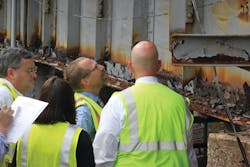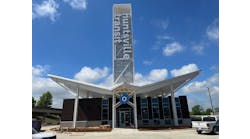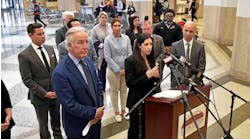“While no piece of legislation is perfect,” says Federal Transit Administrator Peter Rogoff, “By and large MAP-21 has the right policies for transit.”
In a time of short money, it’s especially important to prioritize what dollars there are around safety because, he says, you cannot let safety deteriorate because the funding is tight. “In fact,” he says, “I would question anyone who feels that they can guarantee they know precisely where their greatest safety vulnerabilities are.
“You can’t,” he states. “But you can certainly refine it. You can certainly identify potential risks.”
I ask Administrator Rogoff about some of the concerns I’ve been hearing from people regarding safety requirements. “I think there’s a lot of misinformation out there about what might be required.” He continues, “We’re not looking to burden transit agencies with massive new responsibilities when we know they’re under their own financial stress.”
The whole idea, the safety system management approach, is to get away from the one-size-fits-all solution. Some of the requirements for MAP-21, Rogoff says, were not picked up from the Administration’s bill, they were generated by Congress. The safety management system approach provides scalability so it is appropriate for the size of the particular agency.
While transit is a very safe mode of travel, Rogoff says the challenge is to push forward common sense approaches that allow us to raise our game. “But we also need to demonstrate that actually leads to safety; I’m really not interested in a massive paperwork exercise …"
He continues, “Some people will say that we’re just fine, thank you very much, and then wake up and discover they’ve got issues … the idea is to help train people to be able to discover their safety vulnerabilities — even the ones they don’t see. That’s really the goal.”
In times of short money, he thinks this is even more necessary. It’s not about writing reports, but having a formulaic approach to evaluating information to know the greatest vulnerabilities.
“I think people are accustomed to such a voluminous bureaucratic process that the FTA is known for that they may not believe us,” Rogoff says of the safety management approach. “It will have to play itself out by performance.”
And, even with the FTA facing its own funding shortages, this will be the highest priority within the FTA Rogoff states. “We will have to prioritize it within whatever available funding we have … we’re no just going to throw up our hands and ignore the requirements of MAP-21 because we’ve been sequestered.
“It may be other MAP-21 priorities take longer for our need to move forward on safety.”
During the recent American Public Transportation Association’s Legislative Conference in Washington, D.C., Rogoff spoke to attendees and said, “The law of the land prohibited the FTA from issuing even the most basic common-sense safety standards of any kind since 1964.
“The administration proposed that be reversed in 2009 and indeed, MAP-21 followed our guidance and we now have new safety authority that we will be rolling out in a very level-headed, non-beuarucractic way by adding value to the safety of your operations without adding a great deal of cost.”
Prepared for Disaster
Another important addition with MAP-21 is for emergency response. The new model looks to be more responsive to the needs of transit agencies than the FEMA model.
“It allows transit agencies to gain assistance to after the disaster, actually build the transit system back to a sate of good repair, rather than to whatever it was the day before the disaster,” Rogoff explains. “It also allows funding to prevent future disasters.”
The long-term vision is to have enough money in the bank to deal with disasters, as they occur. The program can’t be built just around Sandy, but will be for hurricanes, tornado, earthquakes — all types of disasters.
During his Legislative Conference remarks, Rogoff said, “When the administration a couple of years ago first proposed in its budget that the FTA have its own emergency relief program on a parallel with the federal highway adminstration’s emergency relief program we could have never anticipated the worst transit disaster ever in the history of transit in the United States, namely Superstorm Sandy.
“Thank heaven MAP-21 put that program on the books because it enabled Congress to provide us with $10.9 billion rapidly and we’ve already awarded $400 million of that amount and more coming in the weeks to come, to aid the busiest transit agencies in the United States …”
Funding Shortfall
While MAP-21 has many of the right policies, it doesn’t have the right funding levels. And during his Legislative presentation, he said, “The No. 1 headwind that we’re encountering is available resources. “
And the sequester has taken $656M out of the Federal Transit Administration, below frozen levels. That has meant a 5 percent cut from the salaries and expenses budget, which pushes that budget back to where it was in 2009 before the added requirements of implementing MAP-21 and before the additional responsibilities of safety regulations.
Rogoff says it is extremely worrisome as it means his employees will be facing furloughs when they should be putting out MAP-21 policy guidance to help agencies do their jobs. It also means the New Starts and Small Starts program has seen cuts.
While the FTA has signed a record number of full funding grant agreements — in 2011 and 2012 it has been more than any other 2-year period in the FTA’s history — they are facing a funding level about 17 percent below what the President asked for, to a funding level that, he said, “Will not allow us to honor the commitments that we made in each of these full funding grant agreements for funding for 2013.
“It is very likely that we’ll have to have across the board cuts against every one of the New Start projects currently in construction.”
With the current resource level, it could undermine transit’s ability to lower our dependence on foreign oil, the ability to mitigate congestion and the ability to provide the service as record numbers are clamoring to transit.
During the Legislative Conference Rogoff spoke to attendees about where things were at a year ago. The House of Representatives was moving forward with plans to strip public transit out of the Highway Trust Fund entirely and instead make funding for public transportation dependent on some of the most controversial legislative proposals put forward, like drilling in the Arctic National Wildlife Refuge.
“The proposal was breathtakingly destructive, politically cynical and it prompted my boss, Secretary LaHood, to say that it was the worst piece of legislation that he had seen in over 30 years of public service.”
He said the industry and Administration worked together to beat back that destructive proposal. And today, “We need your intervention again because recent congressional actions are threatening to send us backwards.”



